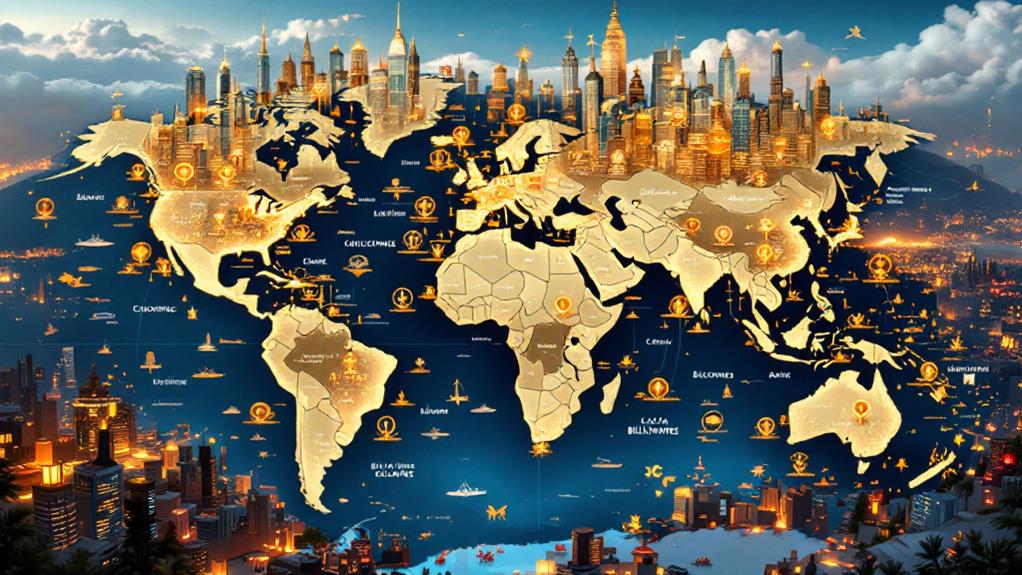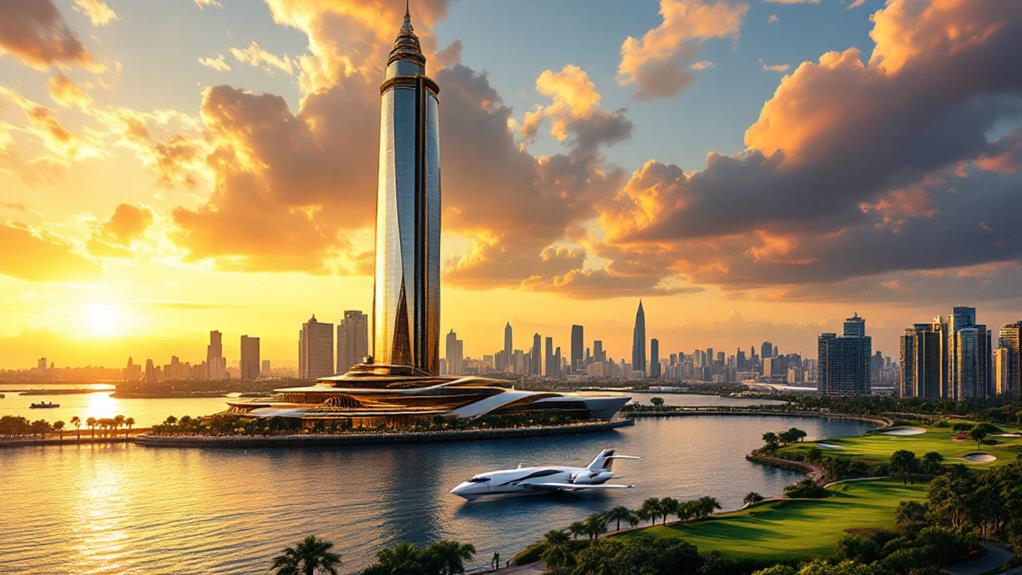Countries With the Most Billionaires: Where the Wealth Resides

You're curious about where the world's wealthiest individuals are clustered. The United States leads with 813 billionaires, reflecting vast economic opportunities. China follows with 406, highlighting its rapid growth. India, third with 200 billionaires, showcases exceptional entrepreneurial spirit. Other notable countries include the United Kingdom, Germany, and Russia. Cities like New York and Moscow host high concentrations of wealth, with emerging hubs such as Los Angeles and Singapore gaining traction. These dynamics offer insights into how wealth is shaping global economies and influencing societal trends. There's much more to uncover on this intriguing wealth distribution landscape.
Global Billionaire Landscape
In the current global economic scene, the distribution of billionaires is both intriguing and telling. As of January 2024, the global billionaire count stands at 2,781, highlighting a concentration of wealth among a select few. You might find it fascinating that nearly half of these wealthiest people are located in just two countries: the United States and China. With 813 billionaires in the U.S. and 406 in China, these nations dominate the landscape of billionaires in the world.
However, don't overlook other countries contributing to the global billionaire count. India follows with an impressive 200 billionaires, while Germany and Russia add 132 and 120, respectively. These numbers reveal a dynamic and shifting landscape where economic conditions and market opportunities play significant roles in determining where the wealthiest people reside.
Interestingly, when you consider per capita measurements, the picture changes. Monaco, despite its small size, boasts a staggering 76.825 billionaires per 1,000 people, highlighting a unique wealth concentration. Meanwhile, Singapore, more globally recognized, leads with 6.591 per 1,000 people. This landscape shows that while wealth is concentrated in larger countries, smaller nations can exhibit significant per capita richness.
Top Countries for Billionaires
Leading the way in the billionaire count, the United States stands unrivaled with 813 billionaires, showcasing its dominant economic prowess. This impressive figure reflects the country's capacity to generate wealth and sustain it across diverse sectors. Not far behind, China claims the second spot with 406 billionaires, highlighting its rapid economic growth and increasing global influence. Together, these two countries encompass nearly 50% of the world's billionaire population, which totals 2,781 individuals. Their significant contributions underscore the concentration of global wealth within these top countries.
India, with its lively economy, ranks third with 200 billionaires. It demonstrates the expanding opportunities and burgeoning entrepreneurial spirit within the country. Meanwhile, the United Kingdom secures the fourth position, boasting 146 billionaires. Germany follows with 132, and Russia with 120, each reflecting unique economic landscapes that foster billionaire growth.
The concentration of billionaires often aligns with major cities, and New York City emerges as the top city for billionaire residents, housing 110 of them. These figures illustrate where wealth tends to cluster and the cities' roles as critical economic hubs. Emerging economies also show a rising trend in billionaire counts, indicating shifts in global wealth distribution.
Billionaires by Population Density

With regard to billionaire density, some countries truly stand out. When you examine the data, Monaco leads the charge with an incredible billionaire density of 76.825 billionaires per 1,000 people. This tiny principality's unique economic landscape creates an unparalleled concentration of wealth. Following Monaco, Singapore ranks highly with a billionaire density of 6.591 per 1,000 people. Its robust financial sector and business-friendly environment attract a significant number of wealthy individuals.
The United States, known for its vast economy, boasts a notable billionaire density as well, with 2.420 billionaires per 1,000 people. The country's entrepreneurial spirit and diversity of industries contribute to this figure. Meanwhile, countries like Italy and Canada also present strong figures, with densities of 1.239 and 1.643 billionaires per 1,000 people, respectively.
On the other hand, you'll find countries such as Nigeria and Bangladesh with very low billionaire densities, highlighting economic disparities. Here's how these countries compare:
- Monaco: 76.825 billionaires per 1,000 people.
- Singapore: 6.591 billionaires per 1,000 people.
- United States: 2.420 billionaires per 1,000 people.
- Italy: 1.239 billionaires per 1,000 people.
These numbers illustrate the varying levels of wealth concentration globally.
Cities With Wealth Concentration
Everywhere you look, cities are becoming hubs for wealth concentration, with some leading the pack. New York City tops the list with an impressive 110 billionaires, boasting a collective net worth of $694 billion. This staggering amount of wealth is greatly fueled by influential figures like Michael Bloomberg and Julia Koch. The city's financial and cultural allure makes it a magnet for billionaires worldwide.
Moscow isn't far behind, experiencing a resurgence in its billionaire count. It now hosts 74 billionaires with a total net worth of $378 billion. Amid economic recovery, Moscow has gained 12 billionaires, showcasing its resilient economy. Likewise, Hong Kong's 74 billionaires hold a combined net worth of $326 billion, marking a steady increase from the previous year.
Meanwhile, Mumbai has emerged as a rising star, now home to 69 billionaires. This marks an increase of 13 from last year, with a total net worth of $379 billion, largely due to the influence of Mukesh Ambani. Emerging cities like Los Angeles and Singapore are also notable. Los Angeles now houses 53 billionaires and Singapore follows closely with 52, driven by growth in tech and finance sectors.
Gender Disparity in Billionaires

While cities like New York and Mumbai showcase growing clusters of wealth, a glaring issue persists beneath the surface: gender disparity among billionaires. As of 2024, only one woman ranks among the 20 richest individuals globally, starkly highlighting this gender imbalance. The percentage of female billionaires remains alarmingly low, sparking debates about gender equality in wealth distribution. Critics note that the elite billionaire class is overwhelmingly male, which perpetuates inequality and exclusion.
Consider these points about gender disparity among wealthy individuals:
- Representation: Female billionaires make up a tiny fraction of the billionaire population, underscoring substantial gender inequality. Despite progress in multiple sectors, women's representation remains disproportionately low.
- Societal Impact: The lack of female billionaires isn't just a financial issue; it's a reflection of broader societal concerns about gender roles and opportunities.
- Policy Discussions: Increasingly, political conversations center on wealth inequality and the lack of female representation, indicating a growing awareness and demand for change.
- Wealth Skew: The general wealth distribution is heavily skewed towards the super-rich, with female billionaires lagging considerably behind men, further entrenching the gender disparity in billionaire ranks.
Understanding this disparity is vital for fostering a more inclusive economic landscape.
Yearly Changes in Billionaire Counts
A remarkable shift in the global billionaire landscape occurred in 2024, with the United States gaining 109 new billionaires, raising its total to 800. In contrast, China experienced a significant decline, losing 155 billionaire residents, which brought its total down to 814. These yearly changes highlight the dynamic nature of wealth distribution, especially between China and the United States, which together hold nearly half of the world's billionaire population, with an impressive 3,279 billionaires between them.
While the U.S. saw a surge in its billionaire count, signaling a robust economic environment and lucrative market opportunities, China's decrease reflects potential economic challenges or shifts in wealth distribution. Other countries, especially those in Europe, showed more stability, with minor fluctuations in their billionaire numbers. This stability indicates resilience in their economic landscapes and the ability to maintain or slightly grow their billionaire populations.
Economic Impacts of Billionaire Growth

The fluctuating numbers of billionaires in countries like the United States and China reflect more than just a shift in wealth; they underscore profound economic impacts. As billionaires rise in emerging economies, they signal not only economic growth but also challenge established wealth hierarchies. This increase in billionaires can reshape wealth distribution, creating both opportunities and concerns.
- Economic Growth and Opportunities: The rise in billionaires often indicates booming industries and lively economies, offering new opportunities for wealth creation. This growth can stimulate innovation and create jobs.
- Wealth Inequality: The concentration of wealth among billionaires often leads to a skewed economic landscape. While some benefit from the economic boom, others may feel left behind, exacerbating wealth inequality.
- Influence on Policy and Markets: Billionaires wield significant influence over global markets and politics. Their decisions can impact everything from stock prices to government policies, sparking debates on economic equity and wealth distribution.
- Evolving Economic Policies: Governments may need to adapt economic policies in response to billionaire demographics. This could include addressing wealth inequality through taxation or other financial regulations.
Understanding these dynamics is essential as billionaire trends continue to shape global economic landscapes.
Data Sources and Variability
When exploring billionaire counts, you'll find that the primary data sources are Forbes and the Hurun Research Institute, each offering distinct perspectives. These organizations regularly publish lists, such as Forbes' billionaire rankings and the Hurun Global Rich List, which aim to capture the total wealth of the world's richest individuals. However, the variability in their estimates can lead to discrepancies, making it tricky to compare billionaire positions across lists.
For instance, high-profile billionaires like Bernard Arnault and Elon Musk might appear in different positions on the Forbes list compared to the Hurun Global Rich List. This variability arises from differences in their methodologies and the timing of data collection. Economic fluctuations and real-time changes in fortunes can further complicate these assessments, leading to inconsistencies in total wealth figures.
Monitoring the reliability of these data sources is essential. It helps guarantee accurate comparisons and provides insights into wealth distribution and billionaire demographics. Consistent data reporting allows for a clearer understanding of trends. When analyzing these billionaire rankings, pay attention to the timing and methodology to make informed assessments about where the wealth truly resides.
Future Trends in Wealth Distribution

You can expect significant shifts in the landscape of wealth distribution as emerging markets gain momentum. As these markets expand, they're likely to alter the current billionaire demographics, potentially reducing global wealth inequality. The rise of new billionaires from these regions can challenge established economic powers and encourage more equitable wealth distribution. Discussions around wealth inequality are intensifying, with activists and policymakers focusing on how billionaire growth affects economic equity.
Economic developments in rapidly growing economies will play a crucial role in shaping wealth distribution. Monitoring billionaire demographics is fundamental to understanding these trends and crafting effective economic policies. Here's what you should keep an eye on:
- Emerging Markets: Countries like India, China, and Brazil are experiencing rapid economic growth, and as their markets develop, they're likely to produce more billionaires, altering the global wealth landscape.
- Female Representation: Although still low, female billionaires may increase as more women break into high-earning sectors.
- Political Discussions: Expect heightened debates on wealth inequality and economic equity as billionaire numbers rise.
- Geographical Distribution: The billionaire count in emerging markets will influence where wealth is concentrated globally.
These factors will define the future of wealth distribution.




